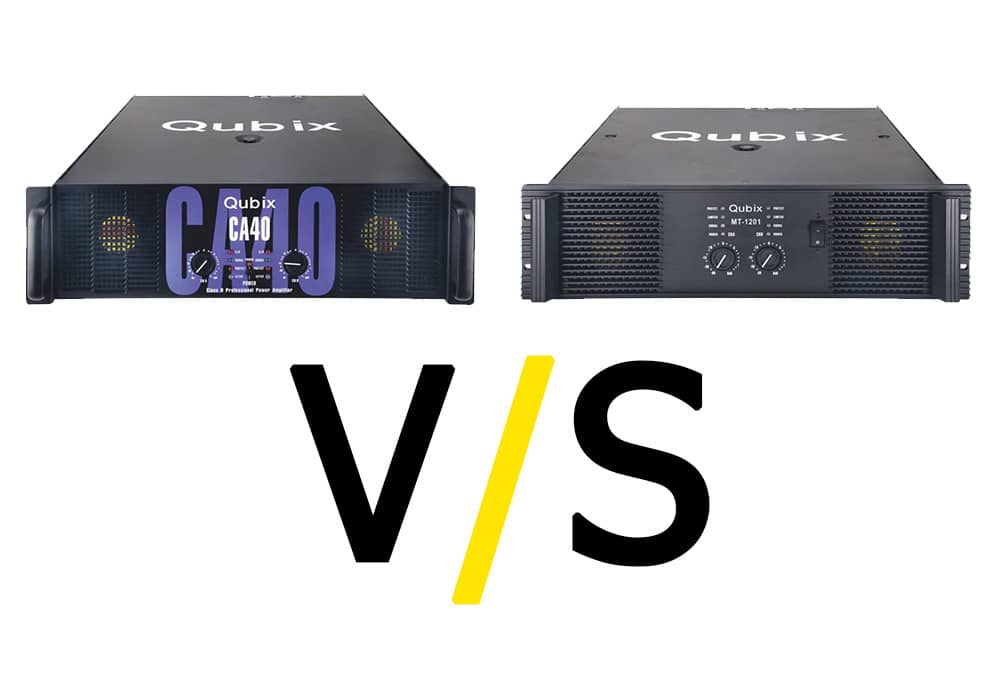
Introduction:
When it comes to professional audio amplification, Qubix is a brand that stands out for its exceptional quality and performance. In this blog post, we will delve into a detailed comparison between two of Qubix’s prominent series: the CA and MT series. These power amplifiers are known for their robust features, reliability, and versatility, making them popular choices for audio enthusiasts, sound engineers, and musicians alike. So, let’s dive in and explore the key similarities and differences between the CA and MT series.
- 1. Power Output:
Both the CA and MT series power amplifiers deliver impressive power outputs. The CA series offers models like the CA-20 and CA-40, which provide 1000W and 2000W per channel respectively at 4 ohms. On the other hand, the MT series offers models like the MT-1201 and MT-1601, which boast higher power outputs of 2100W and 2800W per channel at 4 ohms. The MT series offers a slight edge in terms of power, making it an excellent choice for those seeking higher wattage for larger venues or demanding audio setups.
- 2. Output Circuitry and Damping Factor:
Both the CA and MT series feature class-H output circuitry, ensuring high efficiency and low distortion. The damping factor, a critical parameter for accurate control of low-frequency signals, is >1000 for the MT series and >800 for the CA series. This means that the MT series amplifiers offer better control and tighter sound reproduction in the low-frequency range.
- 3. Input Sensitivity and Flexibility:
The CA and MT series amplifiers provide adjustable input sensitivity options, allowing compatibility with a variety of audio sources. The MT series amplifiers, such as the MT-1201 and MT-1601, offer three input sensitivity options: 0.775 Vms, 1.0 Vms, and 1.4 Vms. In comparison, the CA series amplifiers, like the CA-20 and CA-40, also provide the same input sensitivity options, ensuring compatibility with different audio signal levels. This versatility in input sensitivity makes both series suitable for a wide range of audio setups and equipment.
- 4. Protections and Crossover Options:
Both the CA and MT series prioritize the protection of their amplifiers and connected equipment. They incorporate safeguards such as clip/limit protection, DC protection, and short circuit protection, ensuring reliable operation even in demanding situations. Additionally, both series offer two crossover options, allowing users to fine-tune their sound systems and adapt to different audio requirements.
- 5. Design and Construction:
In terms of design, the CA and MT series amplifiers exude a professional aesthetic. The CA series amplifiers feature a sleek black and aluminum silver finish, while the MT series amplifiers showcase a similar color scheme with added black and metallic blue finishes. The CA series amplifiers have a 3U height, while the MT series amplifiers vary in height with models like the MT-1201 and MT-1601 also having a 3U height, and the MT-5500 boasting a compact 2U height.
Conclusion:
The Qubix CA and MT series power amplifiers both excel in delivering exceptional audio performance and reliability. While the CA series offers robust power output and reliable features, the MT series takes it a step further with higher power outputs, a higher damping factor, and additional versatility in input sensitivity options. Ultimately, the choice between the CA and MT series depends on individual requirements, such as power needs, specific audio setups, and personal preferences.
No matter which series you choose, both the Qubix CA and MT series amplifiers represent an investment in audio excellence, providing the power and performance necessary to bring your sound to life. So, unleash the audio power with Qubix and elevate your sonic experience to new heights.
(Note: The specifications mentioned in this blog post are based on the given information and may be subject to change or vary in different amplifier models. It is always recommended to refer to the specific product documentation or consult with the Brand or authorized dealers for the most accurate and up-to-date information.)




You must be logged in to post a comment.